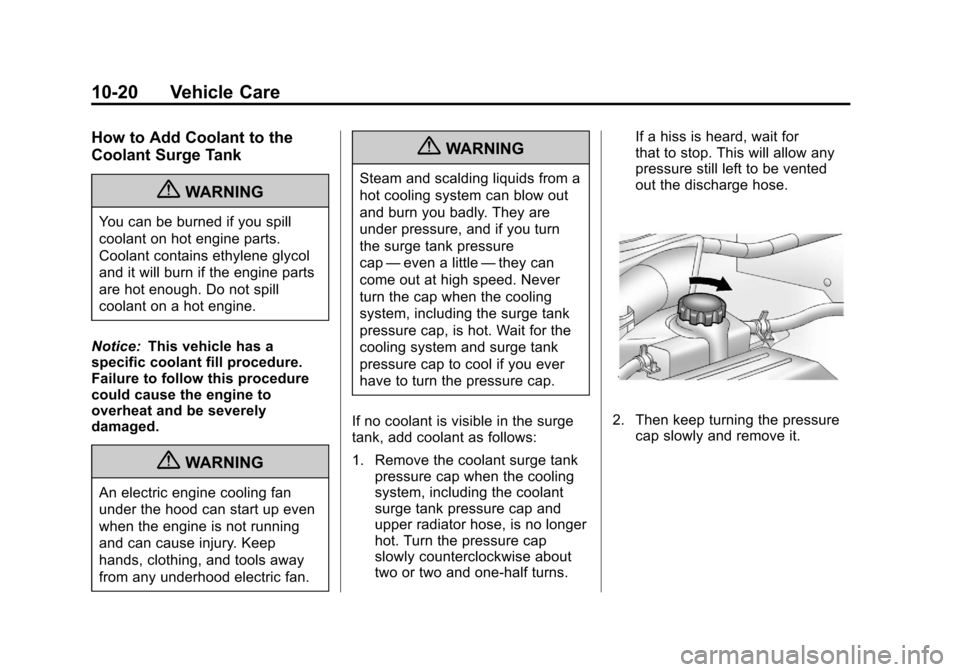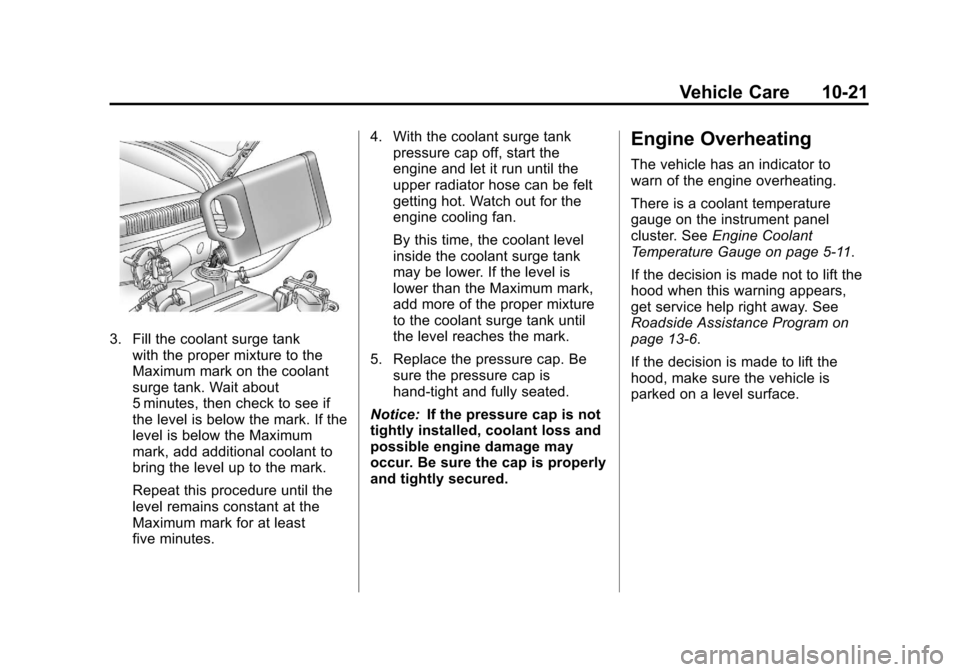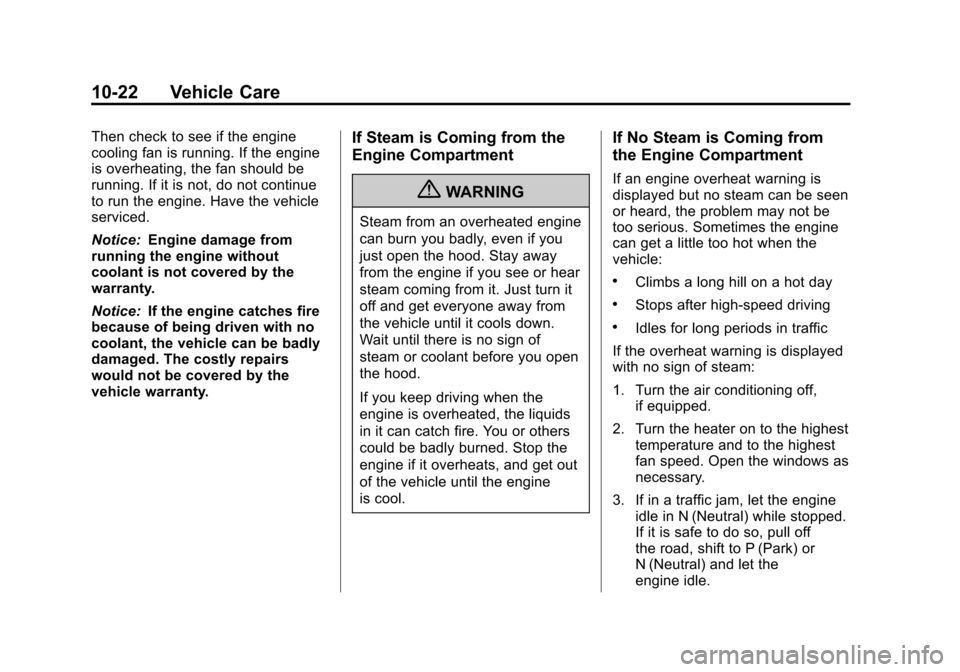Page 19 of 328
Black plate (13,1)Chevrolet Aveo Owner Manual - 2011
In Brief 1-13
Misting Function
Move the lever toward INT for a
single wiping cycle. Hold it there
until the windshield wipers start;
then let go. For several wipes, hold
the band toward INT longer.
Windshield Washer
Pull the windshield washer/wiper
lever toward you to spray washer
fluid on the windshield.
SeeWindshield Wiper/Washer on
page 5‑3. For vehicles with a Rear
Window Wiper/Washer, see Rear
Window Wiper/Washer on page 5‑5.
Climate Controls
For vehicles with these climate
control systems, the heating,
cooling, and ventilation can be
controlled for the vehicle.
Climate Control System with Heater and Air Conditioning
A. Temperature Control
B. Fan Control
C. Air Delivery Mode Control D. Air Conditioning (A/C)
E. Air Recirculation
F. Rear Window Defogger
Page 157 of 328
Black plate (1,1)Chevrolet Aveo Owner Manual - 2011
Climate Controls 8-1
Climate Controls
Climate Control Systems
Climate Control Systems . . . . . . 8-1
Air Vents
Air Vents . . . . . . . . . . . . . . . . . . . . . . 8-4
Maintenance
Passenger Compartment AirFilter . . . . . . . . . . . . . . . . . . . . . . . . . 8-5
Climate Control Systems
For vehicles with these climate control systems, the heating, cooling, and
ventilation can be controlled for the vehicle.
Climate Control System with Heater and Air Conditioning
A. Temperature Control
B. Fan Control
C. Air Delivery Mode Control D. Air Conditioning (A/C)
E. Recirculation
F. Rear Window Defogger
Page 219 of 328

Black plate (17,1)Chevrolet Aveo Owner Manual - 2011
Vehicle Care 10-17
Cooling System
The cooling system allows the
engine to maintain the correct
working temperature.
A. Electric Engine Cooling Fan(Out of View)
B. Coolant Surge Tank with Pressure Cap
{WARNING
An electric engine cooling fan
under the hood can start up even
when the engine is not running
and can cause injury. Keep
hands, clothing, and tools away
from any underhood electric fan.
{WARNING
Heater and radiator hoses, and
other engine parts, can be very
hot. Do not touch them. If you do,
you can be burned.
Do not run the engine if there is a
leak. If you run the engine, it
could lose all coolant. That could
cause an engine fire, and you
could be burned. Get any leak
fixed before you drive the vehicle. Notice:
Using coolant other than
DEX‐COOL
®can cause premature
engine, heater core, or radiator
corrosion. In addition, the engine
coolant may require changing
sooner, at the first maintenance
service after each 30,000 miles
(50 000 km) or 24 months,
whichever occurs first. Any
repairs would not be covered by
the vehicle warranty. Always use
DEX‐COOL
®(silicate‐free) coolant
in the vehicle.
Page 222 of 328

Black plate (20,1)Chevrolet Aveo Owner Manual - 2011
10-20 Vehicle Care
How to Add Coolant to the
Coolant Surge Tank
{WARNING
You can be burned if you spill
coolant on hot engine parts.
Coolant contains ethylene glycol
and it will burn if the engine parts
are hot enough. Do not spill
coolant on a hot engine.
Notice: This vehicle has a
specific coolant fill procedure.
Failure to follow this procedure
could cause the engine to
overheat and be severely
damaged.
{WARNING
An electric engine cooling fan
under the hood can start up even
when the engine is not running
and can cause injury. Keep
hands, clothing, and tools away
from any underhood electric fan.
{WARNING
Steam and scalding liquids from a
hot cooling system can blow out
and burn you badly. They are
under pressure, and if you turn
the surge tank pressure
cap —even a little —they can
come out at high speed. Never
turn the cap when the cooling
system, including the surge tank
pressure cap, is hot. Wait for the
cooling system and surge tank
pressure cap to cool if you ever
have to turn the pressure cap.
If no coolant is visible in the surge
tank, add coolant as follows:
1. Remove the coolant surge tank pressure cap when the cooling
system, including the coolant
surge tank pressure cap and
upper radiator hose, is no longer
hot. Turn the pressure cap
slowly counterclockwise about
two or two and one-half turns. If a hiss is heard, wait for
that to stop. This will allow any
pressure still left to be vented
out the discharge hose.
2. Then keep turning the pressure
cap slowly and remove it.
Page 223 of 328

Black plate (21,1)Chevrolet Aveo Owner Manual - 2011
Vehicle Care 10-21
3. Fill the coolant surge tankwith the proper mixture to the
Maximum mark on the coolant
surge tank. Wait about
5 minutes, then check to see if
the level is below the mark. If the
level is below the Maximum
mark, add additional coolant to
bring the level up to the mark.
Repeat this procedure until the
level remains constant at the
Maximum mark for at least
five minutes. 4. With the coolant surge tank
pressure cap off, start the
engine and let it run until the
upper radiator hose can be felt
getting hot. Watch out for the
engine cooling fan.
By this time, the coolant level
inside the coolant surge tank
may be lower. If the level is
lower than the Maximum mark,
add more of the proper mixture
to the coolant surge tank until
the level reaches the mark.
5. Replace the pressure cap. Be sure the pressure cap is
hand-tight and fully seated.
Notice: If the pressure cap is not
tightly installed, coolant loss and
possible engine damage may
occur. Be sure the cap is properly
and tightly secured.
Engine Overheating
The vehicle has an indicator to
warn of the engine overheating.
There is a coolant temperature
gauge on the instrument panel
cluster. See Engine Coolant
Temperature Gauge on page 5‑11.
If the decision is made not to lift the
hood when this warning appears,
get service help right away. See
Roadside Assistance Program on
page 13‑6.
If the decision is made to lift the
hood, make sure the vehicle is
parked on a level surface.
Page 224 of 328

Black plate (22,1)Chevrolet Aveo Owner Manual - 2011
10-22 Vehicle Care
Then check to see if the engine
cooling fan is running. If the engine
is overheating, the fan should be
running. If it is not, do not continue
to run the engine. Have the vehicle
serviced.
Notice:Engine damage from
running the engine without
coolant is not covered by the
warranty.
Notice: If the engine catches fire
because of being driven with no
coolant, the vehicle can be badly
damaged. The costly repairs
would not be covered by the
vehicle warranty.If Steam is Coming from the
Engine Compartment
{WARNING
Steam from an overheated engine
can burn you badly, even if you
just open the hood. Stay away
from the engine if you see or hear
steam coming from it. Just turn it
off and get everyone away from
the vehicle until it cools down.
Wait until there is no sign of
steam or coolant before you open
the hood.
If you keep driving when the
engine is overheated, the liquids
in it can catch fire. You or others
could be badly burned. Stop the
engine if it overheats, and get out
of the vehicle until the engine
is cool.
If No Steam is Coming from
the Engine Compartment
If an engine overheat warning is
displayed but no steam can be seen
or heard, the problem may not be
too serious. Sometimes the engine
can get a little too hot when the
vehicle:
.Climbs a long hill on a hot day
.Stops after high-speed driving
.Idles for long periods in traffic
If the overheat warning is displayed
with no sign of steam:
1. Turn the air conditioning off, if equipped.
2. Turn the heater on to the highest temperature and to the highest
fan speed. Open the windows as
necessary.
3. If in a traffic jam, let the engine idle in N (Neutral) while stopped.
If it is safe to do so, pull off
the road, shift to P (Park) or
N (Neutral) and let the
engine idle.
Page 239 of 328
Black plate (37,1)Chevrolet Aveo Owner Manual - 2011
Vehicle Care 10-37
Engine Compartment
Fuse Block
The engine compartment fuse block
is located on the driver side of the
vehicle, near the battery. See
Engine Compartment Overview on
page 10‑8for more information on
location.
Notice: Spilling liquid on any
electrical component on the
vehicle may damage it. Always
keep the covers on any electrical
component.
To access the fuses, press in the
side flaps to release the cover. To
reinstall the cover, push the cover
until it is secure.
Fuses Usage
FAN HI Cooling Fan HI
Relay
ABS‐1 EBCM Fuses
Usage
ABS‐2 EBCM
SJB BATT Instrument Panel
Fuse Block
Page 240 of 328
Black plate (38,1)Chevrolet Aveo Owner Manual - 2011
10-38 Vehicle Care
FusesUsage
ACC/IG1 IGN1 Relay
IG2/ST IGN2 Relay, Starter
Relay
ACC/RAP Instrument Panel
Fuse Block
P/
WINDOW‐2 Power Window
Switch
P/W
WINDOW‐1 Power Window
Switch
FAN LOW Cooling Fan LOW
Relay
A/CON A/C Compressor
Relay Fuses
Usage
PKLP LH Tail Lamp (LH),
Side Marker (LH),
Turn Signal &
Parking Lamp (LH),
License Lamp
PKLP RH Tail Lamp (RH),
Side Marker (RH),
Turn Signal &
Parking Lamp
(RH), License
Lamp, I/P Fuse
Block
ECU ECM, TCM
FRT FOG Front Fog Lamp
Relay Fuses
Usage
F/PUMP Fuel Pump Relay
HAZARD Hazard Switch,
Hood Contact
Switch
HDLP HI LH Head Lamp
(LH), IPC
HDLP HI RH Head Lamp (RH) IPC IPC
HDLP LO LH Head Lamp (LH),
I/P Fuse Block
HDLP LO RH Head Lamp (RH) EMS‐1 ECM, InjectorDLIS Ignition Switch